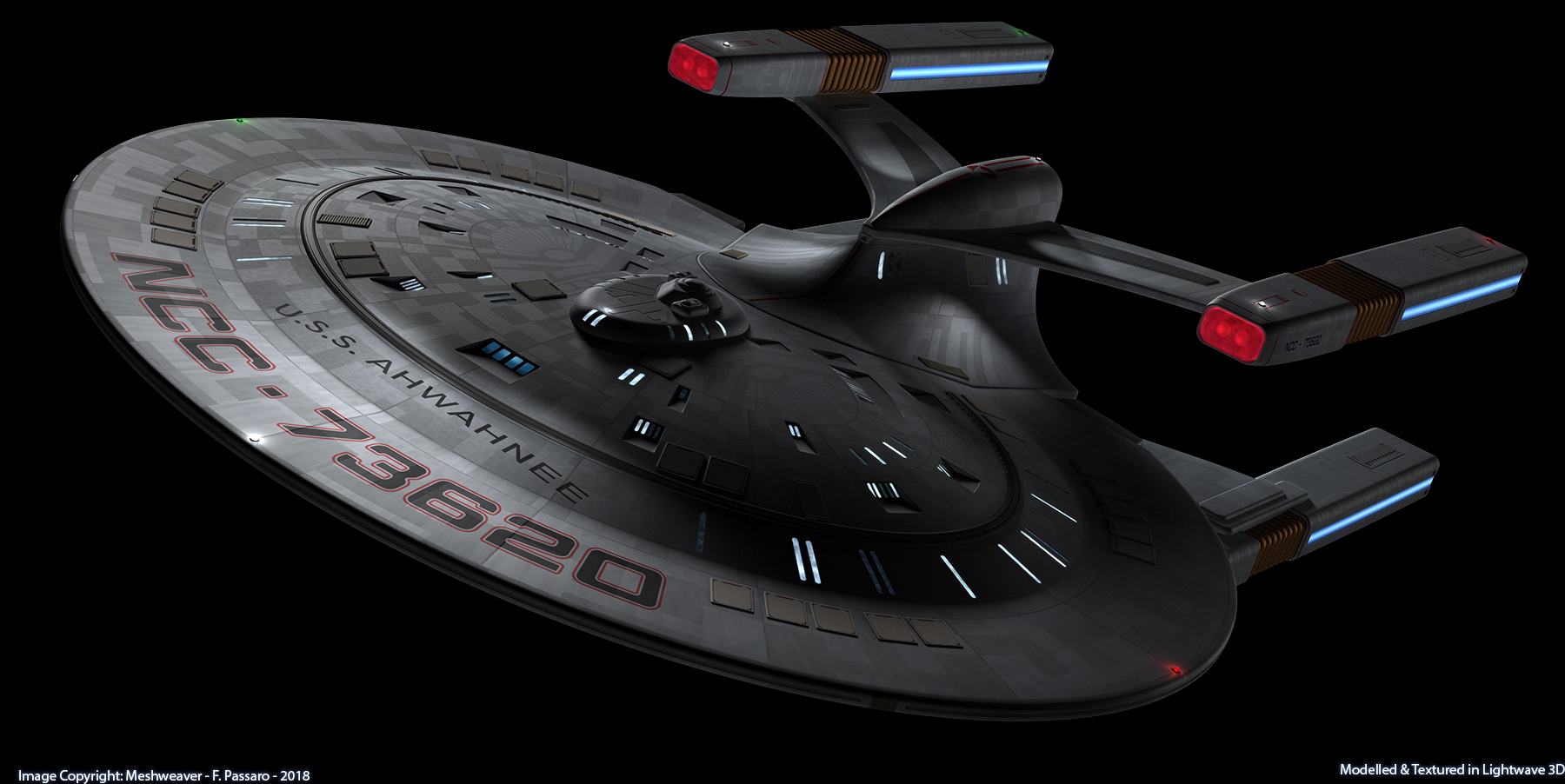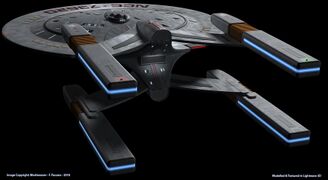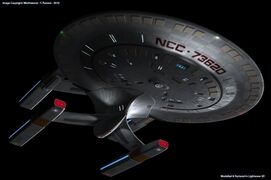Cheyenne Class

| |
| Cheyenne Class | |
| Information | |
| Affiliation | |
| Type |
Light Cruiser |
| Role |
Light Cruiser |
| Service | |
| Operator | |
| Entered Service |
2345 |
| Endurance | |
| Expected Design Life |
80 Years |
| Expected Refit Cycle |
10 Years |
| Expected Resupply Cycle |
1 Year |
| Crew Capacity | |
| Standard Complement |
250 |
| Emergency Capacity |
1,000 |
| Dimensions | |
| Length |
362 meters |
| Width |
262 meters |
| Height |
100 meters |
| Decks |
20 |
| Propulsion | |
| Propulsion Systems |
Matter/Antimatter powered warp drive |
| Cruise Speed |
Warp 6 |
| Maximum Speed |
Warp 8 |
| Emergency Speed |
Warp 9.6 (12 hours) |
| Armaments | |
| Energy Weapons |
|
| Torpedo Launchers |
|
| Torpedo Payload |
|
| Shields |
Multi-Layered Shielding System |
| Small Craft | |
| Shuttlebays |
1 |
| Shuttles |
4 |
| Template:Specification | |
The Cheyenne-class light cruiser is one of the few Starfleet designs with more than two nacelles. This aging class was notionally a successor to the Constellation-class and was first put into service in the 2350s. Like its predecessor, it’s often considered to be underpowered and under-gunned, which leaves it suited to minor duties within Federation space.
Science and Exploration
As a light cruiser, the Cheyenne-class has a number of science labs and is suited to generalist exploratory duties, approximately equal to the Constellation and Miranda-classes in this regard. In the modern era, Cheyenne-class ships are rarely tasked with independent exploratory missions, but they do often find themselves on charting assignments. They have a long band of lateral sensors around the rim of the saucer section that gives them impressive medium-range sensor abilities. This feature makes them better at reconnaissance missions and patrol missions than scientific exploration.
Diplomacy
Cheyenne-class ships have above-average diplomatic capabilities for ships of their size, with enough guest quarters and other accommodations to house multi-party talks aboard the ship. Ships of this type have often been used to host accession talks for potential Federation member worlds, as they are large enough to remain in orbit for several months with enough supplies and recreational facilities to not need extensive support. In support of their diplomatic capabilities, they carry a captain’s yacht. While they are relatively unpopular at Starfleet Command, the Federation Diplomatic Corps has come to be rather fond of these vessels as they are more capable than their younger Challenger-class cousins while also being relatively easy to secure for their missions, given their current second-tier status.
Engineering
One of the few Starfleet designs with four nacelles, the Cheyenne-class has four of the same boxy nacelles developed with her sister class, the Springfield. The design philosophy behind this decision was that the ship would be able to alternate between its two sets of nacelles for normal flight but use all four when high speeds were necessary, but this particular feature was made obsolete by the nacelles introduced on the Challenger-class that would be featured aboard the other ships of this era, which were able to sustain higher speeds with less wear and tear. The engineering section is tall and slender, with the warp core running several decks through the center of it. On the dorsal and ventral surfaces of the secondary hull are mounting points for mission-specific modules. Generally, these are devoted to cargo storage, but they can also be fitted with sensors or other systems.
The primary hull of the Cheyenne-class is larger than the one employed upon the similar Springfield, Challenger, and New Orleans-class ships, with a greater overall diameter, but a similar height. The ship’s primary deflector is located in the saucer section, and the lack of a large dish limits some of its long-range sensor functions. This vessel was one of the first starships that could routinely separate and reconnect its saucer section from the engineering hull. There are clear separation lines on the aft quarter of the saucer section that conceal magnetic docking latches. This feature is primarily employed to allow the saucer section to enter areas where it needs more maneuverability or as a short term solution for combat situations, given that the secondary hull is limited to thruster and warp power because the primary hull contains the impulse engines.
During the Dominion War, vessels of this class often carried extra impulse engines in their mission pods, which allowed them to engage in an early version of Multi-Vector Assault mode, but they have generally returned to their pre-war configuration since then.
The ship’s power grid is limited by the relatively small warp core, which creates limitations during resource-intensive mission profiles. A small number of these vessels have been retrofitted with additional small craft capabilities in the saucer section, replacing the captain’s yacht with a door to a combination shuttle and cargo bay. This makes these ships useful as cargo carriers and humanitarian platforms.
Tactical
The Cheyenne-class has two large Type-X phaser arrays on the ventral and dorsal surfaces of the primary hull, as well as four smaller Type-X arrays on the nacelle pylons, providing near-comprehensive beam weapon coverage of the ship’s firing arcs. In addition, there are four single-fire torpedo launchers, two forward and two aft. As such, this class is rated as a light cruiser and is suitable for low-intensity tactical assignments. It excels especially at hunting smaller raiders.
Due to its power limitations, it is not an ideal tactical platform and generally needs to focus on using its maneuverability to bring its main weapons to bear, rather than using all of its arrays at once. In addition, the single-fire torpedo tubes are much more limited than Starfleet’s other light cruiser classes, and as such this class is often reduced to a combat support role in fleet actions.
Shipboard Life
Similar to her cousins, the Cheyenne-class is a comfortable but not luxurious posting. While the saucer section is larger than on the other classes of this era, more of the ship’s engineering functions are contained within it because of the smaller secondary hull, but most officers still have individual quarters and there are several lounges and holodecks available for recreation.
Crews assigned to these vessels tend to see the assignment as a mere stepping stone to more prestigious or exciting posting, given that these ships are generally not assigned to missions outside of the Federation. Captains especially are often fairly junior and don’t tend to spend long tours on Cheyenne-class ships. Because of high turnover, it’s rare that these ships develop much in the way of esprit de corps or a real sense of ownership over the vessel, given that the longest terms or service tend to be one or two years, rather than the decade or more crews might expect to spend on a large explorer.
Class History
Developed alongside the Springfield class, the Cheyenne-class was seen as a replacement for the Constellation-class cruiser, a vessel once designated as a heavy cruiser, but by the 2340s demoted to simply a ‘cruiser,’ due to the struggles it had with power management. Sharing many components with her sister class, design on the Cheyenne-class continued apace, and it was decided that the design would also incorporate a number of novel features, including an ability to separate the ship’s saucer section and a warp drive system that would rely on alternating sets of warp coils across two pairs of nacelles.
This class experienced significant design challenges, but the first unit was launched in 2345. While Starfleet had optimistically expected to order a few hundred of these vessels, the design proved to be only marginally superior to the Constellation-class, as it suffered from the same power problems as her inspiration. In addition, the saucer separation ability was of extremely limited utility with the arrangement of the ship’s impulse engines being what it was. While initially envisioned as a routinely used ability, it was essentially only used when there was danger of a warp core breach.
Construction continued only for ten years, with only a few dozen ever produced. The USS Ahwahnee was heavily damaged at the Battle of Wolf 359 and a handful were also destroyed during the Dominion War, making them rare by the late 2370s. They continue in service to the present day, but they are becoming increasingly marginalized as time goes on.
Cheyenne Class Gallery
Cheyenne Class In Play
- Underpowered and undergunned just like her Constellation-class predecessor, the Cheyenne is something of an albatross. It’s not a particularly useful design and Starfleet never built many of them, so they’re a rarity.
- A Cheyenne-class is a good first command, as captains typically don’t stick aboard them very long. In some ways service here is a continuation of academy or command school training.
- Cheyenne-class starships might be repurposed as transports or freighters, just like the Miranda before them. They’re a design that would definitely be seen as second-rate by modern Starfleet personnel.


